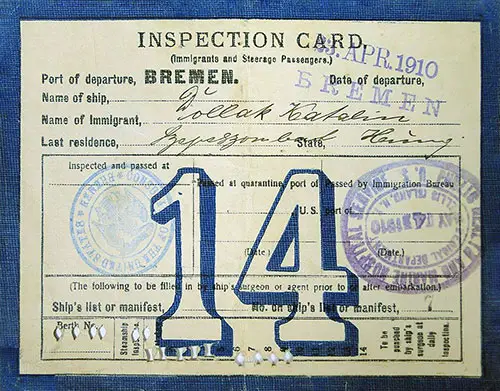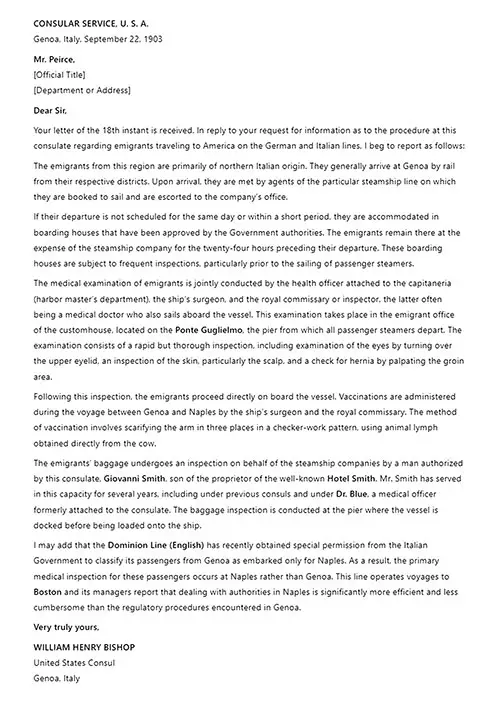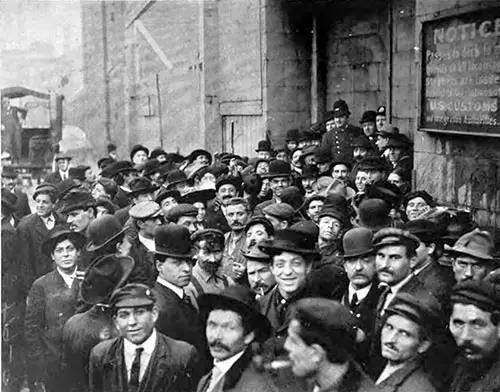Medical and Mental Inspection Of Immigrants

Main Inspection Hall at Ellis Island. Public Hygene, Vol. 2, 1911.GGA Image ID # 154aa73d5a
All steerage passengers are transferred utilizing barges to the immigration depot at Ellis Island. The initial medical examination there conducted is short, but the doctor places a chalk mark upon the suspected parties' clothing at the head of the line.

Barriers Against Invisible Foes - Disease Quarantine
Ellis Island is often remembered as the gateway to the American dream, but it also served as a barrier against invisible threats—infectious diseases that could devastate the population. The quarantine and inspection process for inbound vessels played a crucial role in shaping immigration policies, public health measures, and the experiences of immigrants arriving in the United States. This article, Disease Quarantine of Inbound Vessels, offers a detailed and captivating exploration of how America protected its borders from epidemics while welcoming millions of newcomers. For teachers, students, genealogists, family historians, and researchers, this article is a must-read, providing rare insights into the medical inspections, quarantine procedures, and challenges faced by immigrants before they could set foot on American soil.

The Ellis Island Experience: A Detailed Look at Immigrant Inspection Procedures in 1901
This article provides a compelling and detailed examination of the immigrant inspection process at Ellis Island in 1901, highlighting the challenges, scrutiny, and systematic procedures faced by newcomers to the United States. It offers a rich historical perspective on how medical, legal, and economic concerns shaped U.S. immigration policies at the turn of the 20th century.
For teachers, students, genealogists, and historians, this article is an invaluable resource, helping to contextualize the rigorous screening process that millions of immigrants endured upon arrival in America.
From medical inspections to legal interviews, from contract labor investigations to deportation proceedings, this exploration of Ellis Island provides a powerful insight into the immigrant experience, highlighting the resilience of those who sought a new life in the U.S.

Inspection of Immigrants at Bremen - Norddeutscher Lloyd
For teachers, students, genealogists, and family historians, Inspection of Emigrants by the Hamburg America Line (1903) offers a rare and essential glimpse into the rigorous pre-departure inspections of European emigrants before they reached Ellis Island. This meticulously documented report from Deputy Consul-General Otto W. Hellmrich highlights the intensive medical screenings, quarantine measures, and bureaucratic oversight that shaped the immigrant experience. If you are researching immigrant ancestors from Russia, Austria-Hungary, or other European nations, this article provides firsthand insights into the journey before arrival in the United States—an often-overlooked but crucial piece of the immigration story.

Inspection of Italian Emigrants Going to America on German and Italian Steamship Lines
Ellis Island was the final gateway for many Italian immigrants, but their journey began long before they reached American shores. Inspection of Italian Emigrants Going to America on German and Italian Steamship Lines (1903) provides a rare and detailed glimpse into the pre-departure inspections in Italy, offering invaluable insights for teachers, students, genealogists, and family historians researching Italian immigration. This firsthand account from U.S. Consul William Henry Bishop in Genoa reveals the rigorous medical examinations, government oversight, and shipboard health protocols that shaped the immigration process. For anyone tracing their Italian ancestors or studying immigration history, this article is an essential resource.

Processing Immigrants by the Holland-America Line
The article Processing Immigrants by the Holland-America Line circa 1903 offers a compelling and detailed exploration of the immigrant experience before departing for America. This in-depth historical account provides valuable insights into the rigorous inspection process at Rotterdam, revealing the extent of medical examinations, lodging conditions, baggage inspections, and quarantine measures. For teachers, students, genealogists, family historians, and immigration researchers, this article is an indispensable resource for understanding how European emigrants were processed before their journey to the United States.

Inspection of Emigrants by the Hamburg America Line
For teachers, students, genealogists, and family historians, Inspection of Emigrants by the Hamburg America Line (1903) offers a rare and essential glimpse into the rigorous pre-departure inspections of European emigrants before they reached Ellis Island. This meticulously documented report from Deputy Consul-General Otto W. Hellmrich highlights the intensive medical screenings, quarantine measures, and bureaucratic oversight that shaped the immigrant experience. If you are researching immigrant ancestors from Russia, Austria-Hungary, or other European nations, this article provides firsthand insights into the journey before arrival in the United States—an often-overlooked but crucial piece of the immigration story.

Inspection of Emigrants at Liverpool
The Inspection of Emigrants at Liverpool (1904) provides a fascinating and detailed account of the rigorous pre-departure examinations that emigrants faced before setting sail for America. Liverpool was one of the largest departure points for immigrants traveling to the United States, and its unique passenger processing system highlights the immense logistical and medical scrutiny emigrants underwent. This article is an indispensable resource for teachers, students, genealogists, family historians, and immigration researchers seeking to understand the immigration experience before Ellis Island. It sheds light on the British and American regulations that determined whether an emigrant could board a ship, ensuring that only qualified, healthy, and admissible passengers reached U.S. shores.

Immigration and The Public Health
The Immigration and Public Health (1905) article offers an unparalleled exploration of the intersection between immigration, public health concerns, and policy enforcement at the turn of the 20th century. This in-depth report by Dr. Allan McLaughlin of the U.S. Public Health and Marine Hospital Service provides critical insights into how medical inspections shaped immigration laws, affected immigrant communities, and influenced public health policies in America. For teachers, students, genealogists, family historians, and immigration researchers, this article is an invaluable resource that explains how immigrant health screenings impacted individuals, families, and entire ethnic communities. It also illustrates how evolving medical concerns shaped U.S. immigration laws and reinforced exclusionary policies.

Inspection of Immigrants (1908-1911)
The Inspection of Immigrants (1908-1911) article provides an in-depth look at how the U.S. government regulated immigration through medical and legal inspections at Ellis Island and other ports of entry. It reveals the meticulous screening process, public health concerns, and labor exploitation issues that shaped the immigrant experience. For teachers, students, genealogists, and family historians, this article is a must-read resource to understand how immigration policies influenced the fate of millions of new arrivals. It offers a detailed firsthand account of the procedures, challenges, and the role of government in shaping immigration laws and enforcement.

The Anomalous Quarantine Situation In New York Bay
The Anomalous Quarantine Situation in New York Bay article provides a compelling look at the crucial role New York played in protecting the nation from the spread of infectious diseases while processing millions of immigrants. It highlights the challenges, inconsistencies, and debates over whether quarantine should remain a state responsibility or be transferred to federal control. For teachers, students, genealogists, and family historians, this article is an essential read, offering a deeper understanding of how public health concerns shaped immigration policies at America’s busiest entry port.

The Medical Side Of Immigration
The Medical Side of Immigration article provides an eye-opening look at the critical role medical inspections played in shaping the immigrant experience in early 20th-century America. It highlights how public health concerns influenced immigration policy, national security, and societal perceptions of newcomers. For teachers, students, genealogists, and family historians, this article is an essential resource for understanding how medical inspections impacted the fate of millions of immigrants arriving in the United States.

Scientific Medical Inspection At Ellis Island
For teachers, students, genealogists, and family historians, this article is an invaluable resource that provides firsthand insight into the medical inspection process that determined whether immigrants could begin a new life in America—or be turned away. Ellis Island was the gateway to the American Dream, but for many, medical inspections became an unexpected barrier. This article explores how scientific advancements, mental health assessments, and public health concerns shaped the immigration process in the early 20th century.

Quarantine Procedure at The New York Quarantine Station - 1912
For teachers, students, genealogists, and family historians, this article provides a rare, detailed look into the quarantine process that shaped immigration policy in the early 20th century. Whether your ancestors came through Ellis Island or you’re researching historical public health measures, this piece offers firsthand insight into how medical officers worked to prevent disease outbreaks while processing thousands of immigrants.

Immigration And The Prevention Of Insanity (1913)
For teachers, students, genealogists, family historians, and those studying public health, this article is a critical historical document that explores how early U.S. immigration policies attempted to screen out mental illness among new arrivals. It offers insight into how medical examinations at Ellis Island shaped immigration experiences, influenced public health policy, and affected the lives of countless families whose descendants now seek their stories.

Medical Inspection Of Immigrants At The Port Of Boston- 1914
For teachers, students, genealogists, family historians, and public health researchers, this article provides a crucial historical perspective on immigration inspection in the early 20th century. It details the rigorous medical examinations immigrants faced upon arrival at Boston, one of America’s busiest ports, and highlights the evolution of public health policies and immigration restrictions.

Mental Examination of Immigrants - Administration and Line Inspection at Ellis Island - 1917
For teachers, students, genealogists, family historians, and researchers of public health and immigration, this article offers a rare and detailed look at how immigrants were medically and mentally assessed at Ellis Island during the early 20th century. It sheds light on the rigorous process of screening for mental illnesses and cognitive deficiencies, which played a significant role in determining whether an immigrant would be admitted or deported.
Comprehensive Recap and Summary of the Medical and Mental Inspection of Immigrants Index Page
The Medical and Mental Inspection of Immigrants section presents an essential collection of historical accounts detailing the rigorous screening processes that immigrants underwent before being allowed entry into the United States. For teachers, students, genealogists, family historians, and public health researchers, this collection offers an invaluable perspective on the intersection of immigration, medicine, and public health in the early 20th century.
Each article in this section explores different facets of the immigration inspection process, including medical and mental examinations, disease quarantines, and pre-departure screenings in Europe. These documents shed light on the policies, scientific methods, and societal concerns that shaped the experiences of millions of immigrants.
Highlighted Articles – Best Choices for Deeper Exploration
🏆 Top Picks for Teachers and Students Studying Immigration History
1. Inspection of Immigrants at Ellis Island (Circa 1901)
📖 Why Read This? This article provides an eye-opening first-hand account of the inspection process at Ellis Island, detailing how immigrants were scrutinized by government officials before being granted entry. It gives insight into the medical and legal hurdles that shaped the immigrant experience and the broader U.S. immigration policies of the time.
🔍 Best For: Teachers and students looking for a detailed case study on Ellis Island and immigration regulations.
2. Disease Quarantine of Inbound Vessels – Barriers Against Invisible Foes
📖 Why Read This? This article delves into how the fear of epidemics like cholera and smallpox led to strict medical inspections and quarantine procedures before immigrants could disembark. It highlights the tension between public health concerns and immigration policies, offering a critical look at how health crises shaped American immigration history.
🔍 Best For: Those studying public health, epidemiology, or early American immigration policies.
3. Immigration and Public Health (1905)
📖 Why Read This? This piece explores the intersection of public health and immigration policy, showing how medical screening influenced immigrant communities, national security concerns, and exclusionary policies. It is a must-read for those interested in how public health measures shaped legal immigration restrictions.
🔍 Best For: Researchers in public health, medical history, and legal studies.
🏆 Top Picks for Genealogists and Family Historians Tracing Their Ancestors
4. Inspection of Emigrants at Bremen – Norddeutscher Lloyd & Hamburg America Line (1903)
📖 Why Read This? This article documents the pre-departure medical inspections in Germany, offering rare insight into the journey of European emigrants before reaching Ellis Island. It details the bureaucratic, medical, and quarantine procedures that immigrants had to navigate even before boarding ships.
🔍 Best For: Genealogists and family historians researching German, Russian, or Eastern European immigrant ancestors.
5. Inspection of Italian Emigrants Going to America (1903)
📖 Why Read This? This article provides a firsthand report from U.S. officials stationed in Italy, detailing how Italian immigrants were medically screened and processed before embarking on their journey to America. It highlights government oversight, health concerns, and the conditions aboard steamships.
🔍 Best For: Those researching Italian ancestors or interested in the Italian immigrant experience.
6. Processing Immigrants by the Holland-America Line (1903)
📖 Why Read This? This article describes pre-departure screening at Rotterdam, giving genealogists a detailed look at how Dutch, Belgian, and Central European emigrants prepared for their transatlantic voyage.
🔍 Best For: Researchers tracing ancestors from the Netherlands, Belgium, or Germany.
🏆 Top Picks for Public Health and Immigration Policy Researchers
7. Mental Examination of Immigrants – Administration and Line Inspection at Ellis Island (1917)
📖 Why Read This? This article gives an in-depth look at how mental illness and cognitive abilities were assessed at Ellis Island. It details the screening methods, the psychological tests used, and how immigration officials decided who was mentally fit to enter the U.S..
🔍 Best For: Researchers studying mental health policies, immigration law, and medical history.
8. Immigration and the Prevention of Insanity (1913)
📖 Why Read This? This report explores the controversial methods used to screen out individuals with suspected mental illness, shedding light on how psychiatric diagnoses influenced immigration policies. It raises critical questions about medical ethics and immigration law.
🔍 Best For: Those interested in psychiatric history, eugenics, and early mental health policies in America.
9. Medical Inspection of Immigrants at the Port of Boston (1914)
📖 Why Read This? This article provides a unique comparison of Ellis Island with Boston’s immigration station, highlighting regional differences in medical screening and public health enforcement.
🔍 Best For: Those interested in Boston’s immigrant history and regional immigration policies.
🏆 Best Articles for Understanding Quarantine and Public Health Protocols
10. Quarantine Procedure at The New York Quarantine Station (1912)
📖 Why Read This? A rare, detailed look into the quarantine process that shaped early 20th-century immigration policy. This article is particularly useful for those studying public health enforcement and how outbreaks were contained before immigrants arrived at Ellis Island.
🔍 Best For: Public health researchers, medical historians, and genealogists.
11. The Anomalous Quarantine Situation in New York Bay
📖 Why Read This? This article explains the challenges, inconsistencies, and debates over quarantine procedures, including whether they should be handled at the state or federal level.
🔍 Best For: Those researching public health administration and disease control policies in U.S. history.
Final Thoughts – Why This Collection is a Must-Read
The Medical and Mental Inspection of Immigrants section provides a comprehensive historical overview of the public health challenges, legal barriers, and medical advancements that shaped immigration to America. These articles offer firsthand accounts, government reports, and expert analyses, making them an invaluable resource for a wide audience.
📌 Teachers and students will find rich primary sources for classroom discussions on immigration and public health.
📌 Genealogists and family historians can gain crucial insights into their ancestors' immigration experiences.
📌 Public health researchers and policymakers can explore the historical context of disease prevention and immigration laws.
By exploring these well-documented and historically significant articles, readers gain a deeper understanding of how medical screenings, mental examinations, and quarantine regulations shaped the American immigration system—and, ultimately, the nation itself.
